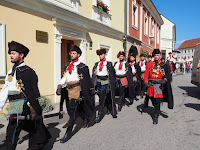Croatia, though a small country has made a name for herself particularly in the sports arena. With a population of just about 4.2 million, it managed to secure a place in the recently concluded World Cup 2018 Final. In Tennis, Marin Cilic, a Croatian has consistently made it to the world top 10. Croatia won the Davis Cup in 2005 and again in 2018.
With the growing prominence of Croatia in sports, anything with an appearance of checkerboard of red and white is quickly being recognized as Croatian.







With the growing prominence of Croatia in sports, anything with an appearance of checkerboard of red and white is quickly being recognized as Croatian.
Croatians are predominantly Christians at 91%. Among them, 86% are Catholics and just under 5% Orthodox Christians. But Protestant Christians are slowing growing - likely brought in by non-Croatians. We saw a vibrant group of Baptists worshiping in an open hall converted from shoplot. This is typically different from their Catholic brethren who worship in huge old cathedrals and church buildings.

************************************************
There are many Catholic churches around the vicinity of the Upper town and Lower town of Zagreb all within walking distance from each other.
 |
| St. Catherine Catholic Church of Baroque architecture was completed in 1632. |


Greek Catholic Co-cathedral of Saints Cyril and Methodius built in 1681
Zagreb Cathedral in Kaptol, is recognized as the most monumental sacred building in Gothic design in this part of the world. Since we spent the whole day of 16 September in Zagreb, we managed to see some of the magnificent buildings under bright sunlight as well as in twilight in the evening.










************************************************
As we moved from the Upper town to the Lower town, we bumped into the Cravat Regiment which had just completed their routine changing of guard at St. Mark Square. The uniforms they wear are replicas of those worn by the military forces called the Croats which fought during the "Thirty Years" War.



*************************************************
Dolac market in the heart of Zagreb is the city's main flea or open-air farmers' market. Unlike our local tamu, the rows and rows of vendors in Dolac market are instead neatly arranged and covered with the same pink-white standard size beach-umbrella canopies. This is a one-stop centre where almost all local stuff both edible and non-edible are marketed. Compared to their other European counterparts, things here are generally cheaper because Croatians have their own currency, the Croatian Kuna,





Whenever you are thirsty or hungry, there are plenty of eateries, cafe and restaurants around the market to choose from.





No comments:
Post a Comment